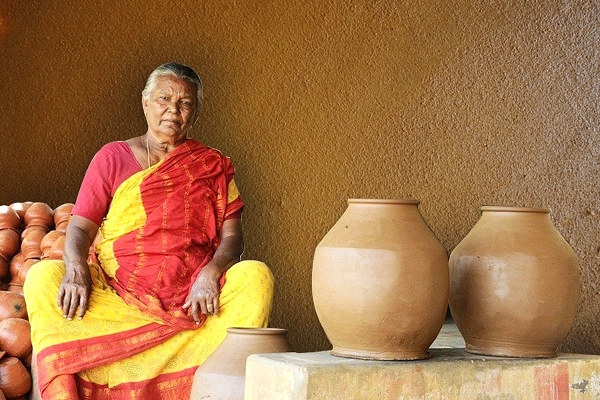
Obit: Meenakshi Kesavan, Who Helped Turn Soil Into Sound All Her Life, Is No More
The only lady who has been moulding the magic pot – ghatam – for decades, Meenakshi Kesavan bid farewell to the world today (7 November).
Beat a pot once and it is broken. So what do you think will happen if you beat a pot around 3,000 times? It turns into a womb of sound that has redefined classical Carnatic music experience for decades now.
The ghatam, a percussion instrument, is a clay pot with a narrow mouth. From the mouth, it slants outwards to form a ridge. As much of an art it is to play it, an even more skillful task is to make it, and one family in Manamadurai has been running the show for decades now.
But ghatam players all over the world felt a sense of being orphaned as the only lady who has been moulding the magic pot for decades, Meenakshi Kesavan, bid farewell to the ghatam and the world today (7 November).
Percussionist Ghatam Giridhar Udupa expressed the magnitude of loss, saying, “I owe a great part of my existence to her. The loss is yet to sink in.”
Meenakshi amma, who had inherited the skill from her husband, has seen her ghatams tour the world with many a renowned player of the instrument, and had the biggest names of the music industry, such as the likes of A R Rahman, Sivamani and Illayaraja, as her clientele, and was also awarded the Sangeet Natak Akademi award (puraskar) in 2013 for her contribution to making ghatam.
Udupa’s last visit to Meenakshi amma’s place in January this year is still fresh in his mind as he says that the relationship between them was not that of a buyer and maker. “She was like a mother, full of affection”, he muses, adding that things will not be the same again, though her son too has inherited the skill from his mother.
Every time he holds the ghatam or travels with it, he says he has always been scared as this family is the only one that makes ghatams in this way. “All ghatam players will share this feeling. My first visit to her house was an eye opener that while we travel the world and perform in front of thousands of people, there is this tiny small family tucked away in a corner of a village that we owe a large part of our existence to.”
Describing her commitment to creating this unique pot, Udupa ruminates, “Can you imagine someone waking up every day for over four decades to turn clay into music, beating it over a thousand times. Not for a single day would she have taken a break from the task. Even her ill health couldn’t keep her away from the ghatam.”
Although it can easily be mistaken for an ordinary clay pot, the making of a ghatam is an art not many can boast of being able to imbibe easily. The walls of a ghatam are twice as thick as that of an ordinary cooking pot. And the Manamadurai one is the best one known to have a special tonal quality.
One tap at a time, she has beaten and turned mud from ponds located in and around her region into wombs of percussion sounds. But alas, not any more.
Image Credit: Prakruti P Kumar